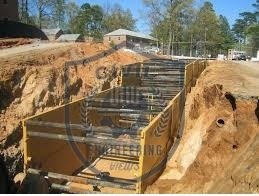All Step And Precaution For excavation Work
In this article, I will explain all the basic steps for excavation and what are the basic precautions to perform the excavation work in the construction. Excavation work is a critical aspect of various construction projects, ranging from building foundations to laying pipelines. It involves digging and removing earth to create cavities of specific shapes and sizes. All Step And Precaution For excavation Work
Introduction of Excavation
Excavation work is a critical aspect of various construction projects, ranging from building foundations to laying pipelines. It involves digging and removing earth to create cavities of specific shapes and sizes. While it’s an essential part of construction, excavation can also be hazardous if not done properly. Therefore, it’s crucial to follow a systematic approach and take necessary precautions to ensure safety and efficiency. In this comprehensive guide, we’ll explore the step-by-step process of excavation work along with essential precautions to mitigate risks.
All Step And Precaution For excavation Work
Basic Steps for Excavation Work
Before starting excavation must be checked all area to clear all obstructions like any safety hazards and also check all underground utilities like cable pipes line etc.
Project Planning and Site Assessment
- Before starting excavation, thoroughly assess the site to identify any potential hazards, such as underground utilities, unstable soil conditions, or environmental concerns.
- Develop a detailed excavation plan that includes the dimensions, depth, and layout of the excavation area.
Obtain any necessary permits and approvals from local authorities.
Clearing and Marking the Work Site
- Clear the site of any vegetation, debris, or obstacles that may interfere with the excavation process.
- Mark the boundaries of the excavation area using stakes, flags, or other visible markers to ensure accuracy.
Utility Detection and Protection
- Use utility detection equipment, such as ground-penetrating radar cable detectors or electromagnetic locators, to identify the location of underground utilities like pipes, cables, and wires.
- Take appropriate measures to protect and/or relocate utilities to prevent damage during excavation.
Excavation Equipment and Machinery
Select the appropriate excavation equipment based on the soil type, depth, and project requirements. Common equipment includes excavators, backhoes, bulldozers, and trenchers. Ensure that all machinery is in good working condition and operated by trained personnel.
Digging and Shoring
Begin digging according to the excavation plan, like hand digging or manual excavation, or excavation with a machine must be maintaining proper slope angles and depths.
Install shoring systems, such as trench boxes, hydraulic shores, timber supports, or plywood scaffolding planks or pipes to prevent soil collapse and protect workers from cave-ins.

Soil Management and Disposal
Manage excavated soil responsibly, following local regulations for disposal or reuse.
Prevent soil erosion and sediment runoff by implementing erosion control measures, such as silt fences or sediment traps.
Inspection and Monitoring
Conduct regular inspections of the excavation site to ensure compliance with safety regulations and project specifications.
Monitor soil conditions, weather forecasts, and any changes that may affect the stability of the excavation.
Backfilling and Restoration
Backfill the excavation area with suitable materials, compacting each layer to achieve the desired density.
Restore the site to its original condition or as specified in the project plans, including grading, landscaping, and paving if necessary.
Precautions for Excavation Work
-
Method of Dewatering In The Civil Engineering
-
What Is RFI And How To Make RFI
-
How To Make Method Statements For Reinforcements Formwork And Concrete Work
Safety Training and Procedures
Provide comprehensive safety training for all excavation personnel, including proper equipment use, hazard recognition, and emergency procedures.
Develop and enforce strict safety protocols, such as wearing personal protective equipment (PPE), establishing exclusion zones, and conducting toolbox talks before each shift.

Ground Stability and Soil Testing
Conduct soil tests to determine the stability and load-bearing capacity of the excavation site.
Monitor soil conditions throughout the excavation process and take corrective action if signs of instability or movement are detected.
Trenching and Excavation Safety
Follow OSHA (Occupational Safety and Health Administration) regulations and industry best practices for trenching and excavation, including proper sloping, benching, or shoring techniques.
Never enter an unprotected trench or excavation without adequate safeguards in place.
Utility Identification and Protection
Use utility maps, as-built drawings, and utility locating services to identify the location of underground utilities before excavation accurately.
Implement safe digging practices, such as hand digging or vacuum excavation, when working near utilities to avoid accidental damage.
Equipment Operation and Maintenance
Ensure that all excavation equipment is operated by trained and competent personnel who understand the risks and limitations of the machinery.
Perform regular maintenance checks and inspections on equipment to identify and address any mechanical issues promptly.
Emergency Preparedness
Develop an emergency response plan that outlines procedures for dealing with accidents, injuries, or emergencies on the excavation site.
Keep emergency contact information readily available and ensure that all workers know how to respond to different scenarios.
Environmental Protection
Minimize environmental impact by implementing erosion control measures, controlling sediment runoff, and preventing contamination of soil and water resources.
Comply with environmental regulations and obtain permits as required for excavation activities near sensitive habitats or water bodies.
Communication and Coordination
Maintain open communication channels between all stakeholders involved in the excavation project, including contractors, subcontractors, engineers, and regulatory agencies.
Coordinate work schedules, logistics, and safety measures to ensure smooth operations and timely completion of the project.
By following these steps and precautions, excavation work can be carried out safely and efficiently, minimizing risks to workers and the surrounding environment. Prioritizing safety, proper planning and adherence to regulations are essential for successful excavation projects.
Read More
Unearthing the Foundations And Exploring the Fundamentals of Soil Mechanics
Civil Engineering Important Information And Knowledge
What is The Differences B/W RCC And PCC And How To Calculate Cement Sand And Aggregate In 1cum



[…] All Step And Precaution For excavation Work […]